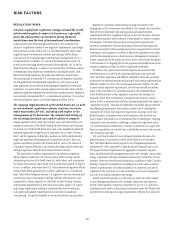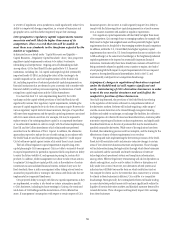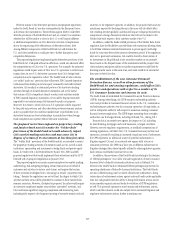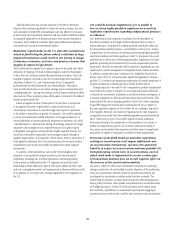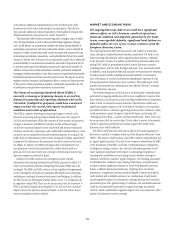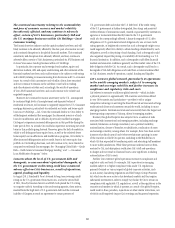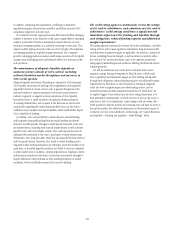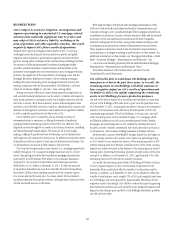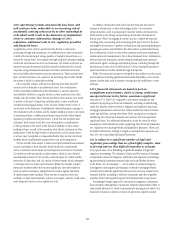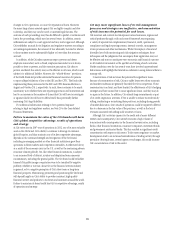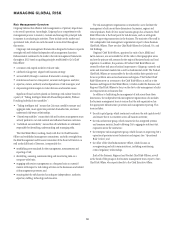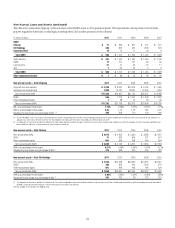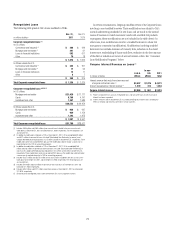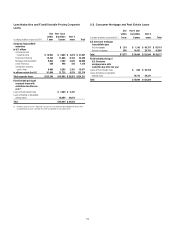Citibank 2011 Annual Report Download - page 87
Download and view the complete annual report
Please find page 87 of the 2011 Citibank annual report below. You can navigate through the pages in the report by either clicking on the pages listed below, or by using the keyword search tool below to find specific information within the annual report.65
changes in Citi’s operations, or cause Citi reputational harm. Moreover,
the many large claims asserted against Citi are highly complex and slow
to develop, and they may involve novel or untested legal theories. The
outcome of such proceedings may thus be difficult to predict or estimate until
late in the proceedings, which may last several years. In addition, certain
settlements are subject to court approval and may not be approved. Although
Citi establishes accruals for its litigation and regulatory matters according to
accounting requirements, the amount of loss ultimately incurred in relation
to those matters may be substantially higher or lower than the amounts
accrued.
In addition, while Citi takes numerous steps to prevent and detect
employee misconduct, such as fraud, employee misconduct is not always
possible to deter or prevent, and the extensive precautions Citi takes to
prevent and detect this activity may not be effective in all cases, which could
subject it to additional liability. Moreover, the “whistle-blower” provisions
of the Dodd-Frank Act provide substantial financial incentives for persons
to report alleged violations of law to the SEC and the CFTC. The final rules
implementing these provisions for the SEC and CFTC became effective in
August and October 2011, respectively. As such, there continues to be much
uncertainty as to whether these new reporting provisions will incentivize and
lead to an increase in the number of claims that Citi will have to investigate
or against which Citi will have to defend itself, thus potentially further
increasing Citi’s legal liabilities.
For additional information relating to Citi’s potential exposure
relating to legal and regulatory matters, see Note 29 to the Consolidated
Financial Statements.
Failure to maintain the value of the Citi brand could harm
Citi’s global competitive advantage, results of operations
and strategy.
As Citi enters into its 200th year of operations in 2012, one of its most valuable
assets is the Citi brand. Citi’s ability to continue to leverage its extensive
global footprint, and thus maintain one of its key competitive advantages,
depends on the continued strength and recognition of the Citi brand,
including in emerging markets as other financial institutions grow their
operations in these markets and competition intensifies. As referenced above,
as a result of the economic crisis in the U.S. as well as the continuing adverse
economic climate globally, Citi, like other financial institutions, is subject
to an increased level of distrust, scrutiny and skepticism from numerous
constituencies, including the general public. The Citi brand could be further
harmed if its public image or reputation were to be tarnished by negative
publicity, whether or not true, about Citi or the financial services industry
in general, or by a negative perception of Citi’s short-term or long-term
financial prospects. Maintaining, promoting and positioning the Citi brand
will depend largely on Citi’s ability to provide consistent, high-quality
financial services and products to its clients and customers around the world.
Failure to maintain its brand could hurt Citi’s competitive advantage, results
of operations and strategy.
Citi may incur significant losses if its risk management
processes and strategies are ineffective, and concentration
of risk increases the potential for such losses.
Citi monitors and controls its risk exposure across businesses, regions and
critical products through a risk and control framework encompassing
a variety of separate but complementary financial, credit, operational,
compliance and legal reporting systems, internal controls, management
review processes and other mechanisms. While Citi employs a broad and
diversified set of risk monitoring and risk mitigation techniques, those
techniques and the judgments that accompany their application may not
be effective and may not anticipate every economic and financial outcome
in all market environments or the specifics and timing of such outcomes.
Market conditions over the last several years have involved unprecedented
dislocations and highlight the limitations inherent in using historical data to
manage risk.
Concentration of risk increases the potential for significant losses.
Because of concentration of risk, Citi may suffer losses even when economic
and market conditions are generally favorable for Citi’s competitors. These
concentrations can limit, and have limited, the effectiveness of Citi’s hedging
strategies and have caused Citi to incur significant losses, and they may do
so again in the future. In addition, Citi extends large commitments as part
of its credit origination activities. If Citi is unable to reduce its credit risk by
selling, syndicating or securitizing these positions, including during periods
of market dislocation, Citi’s results of operations could be negatively affected
due to a decrease in the fair value of the positions, as well as the loss of
revenues associated with selling such securities or loans.
Although Citi’s activities expose it to the credit risk of many different
entities and counterparties, Citi routinely executes a high volume of
transactions with counterparties in the financial services sector, including
banks, other financial institutions, insurance companies, investment banks
and government and central banks. This has resulted in significant credit
concentration with respect to this sector. To the extent regulatory or market
developments lead to an increased centralization of trading activity through
particular clearing houses, central agents or exchanges, this could increase
Citi’s concentration of risk in this sector.


